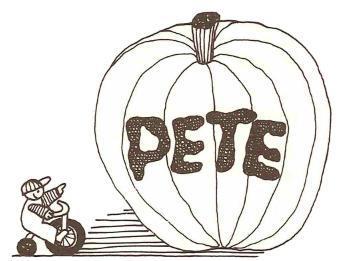 Pumpkins are the quintessential fall crop in many parts of the country and a favorite winter squash-yes, pumpkins are squashes, too! Most pumpkins are in the Cucurbita pepo species, directly related to acorn and spaghetti squashes. There are many varieties to choose among. Some are best for carving into jack-o-lanterns, some are bred for cooking and still others were developed just for their tasty seeds. The "Atlantic Giant" types were bred purely for size-they can be truly enormous. Pumpkins are grown similarly to winter squash and require plenty of space to vine.
Pumpkins are the quintessential fall crop in many parts of the country and a favorite winter squash-yes, pumpkins are squashes, too! Most pumpkins are in the Cucurbita pepo species, directly related to acorn and spaghetti squashes. There are many varieties to choose among. Some are best for carving into jack-o-lanterns, some are bred for cooking and still others were developed just for their tasty seeds. The "Atlantic Giant" types were bred purely for size-they can be truly enormous. Pumpkins are grown similarly to winter squash and require plenty of space to vine.
Whether you want to challenge the world's record for pumpkin size (it's presently more than 1,000 pounds), or just want to have fun growing a huge pumpkin, that fruit will need lots of water, fertile soil, pampering and care. If you want to go for it, follow these steps.
Days to maturity are from seeding in the garden until first harvest.
'Atlantic Giant' (115) 1,000 pounds; Requires lots of water, heat and feeding to reach its 1,000-pound potential; also good for pies.
'Baby Bear' (105) 2 pounds; All American Selection (AAS) winner; the semi-naked (thin-hulled) seeds of this miniature variety are great for roasting and the flesh is good for cooking.
'Connecticut Field' (115) 20 pounds; Flat-bottomed jack-o-lantern type; great for carving or baking.
'Lumina'(95) 20 pound; Unusual white-skinned, orange-fleshed variety good for ghostly jack-o-lanterns.
'Rouge Vif d'Etampes' (115) 10 pounds; Attractive red-skinned, French type that looks like a cheese wheel; good for pies. Also known as 'Cinderella'.
'Small Sugar' (95) 8 pounds; The pumpkin for pies; fruits have smooth flesh and a small seed cavity.
'Trick or Treat' (110) 8 pounds; All-purpose type developed for seed roasting, but also good for carving and pies; the "naked" seeds are slower and more finicky about germinating than other pumpkin varieties.
 Victory Seed Company has all the seeds you want for your best garden in 2024.
Victory Seed Company has all the seeds you want for your best garden in 2024.
For 25 years, the family-owned Victory Seed Company has provided the highest quality vegetable, herb and flower seeds to families across the country. We are passionate about providing you the best seeds available that give excellent germination, robust plants, and the harvest you want. With a catalog of over a thousand varieties, we have everything, and our prices are the kinds that we'd want to pay. We have hundreds of yesterday's heirloom vegetables, as well as today's award winning hybrid selections. Get to know us by visiting our website and browsing through our online vegetable seed catalog.
| 1. Getting Started with Vine Crops |
| 2. Cucumber Varieties |
| 3. Getting to Know Squash |
| 4. Melon Varieties |
| 5. Pumpkin Varieties & Growing Big Ones ← you're on this article right now |
| 6. Ornamental and Unusual Gourds |
| 7. How All Vine Crops Grow |
| 8. Cross Pollinating Melons and Squash |
| 9. Cucumber Essentials |
| 10. Melon Essentials |
| 11. Pumpkin Essentials |
| 1. Getting Started with Vine Crops |
| 2. Cucumber Varieties |
| 3. Getting to Know Squash |
| 4. Melon Varieties |
| 5. Pumpkin Varieties & Growing Big Ones ← you're on this article right now |
| 6. Ornamental and Unusual Gourds |
| 7. How All Vine Crops Grow |
| 8. Cross Pollinating Melons and Squash |
| 9. Cucumber Essentials |
| 10. Melon Essentials |
| 11. Pumpkin Essentials |